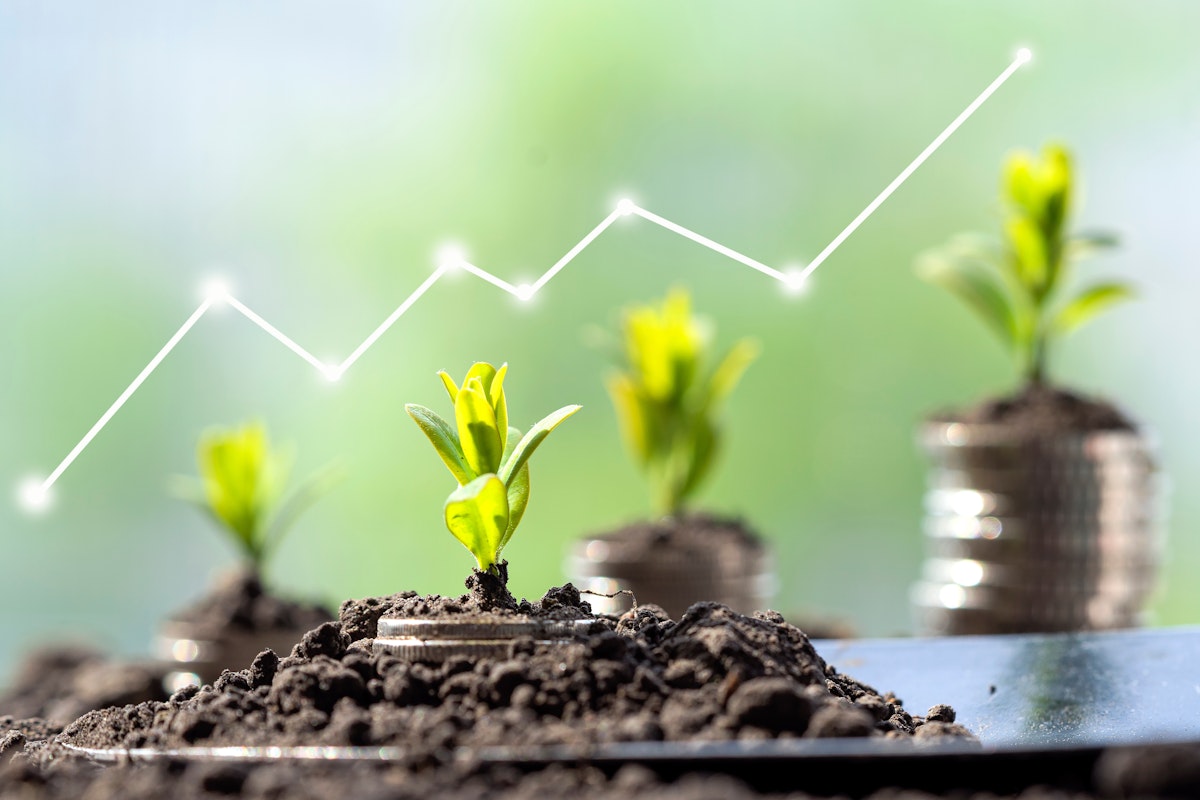The Case for Doubling Down on Agricultural R&D
More food, better land use, and less greenhouse gases

-
-
Share
-
Share via Twitter -
Share via Facebook -
Share via Email
-
Doubling government funding for agricultural research and development (R&D) would have tremendous environmental and economic benefits, according to a new BTI-commissioned paper in the Journal of Agricultural and Applied Economics. A substantial increase in R&D funding is needed now more than ever to manage extreme weather and new pest pressures, to help U.S. farmers better compete with producers internationally, and to reduce the food system’s large environmental footprint.
However, increasing R&D funding would require a significant new commitment from policymakers. After reaching a peak in 2002, spending on U.S. public agricultural R&D has fallen by approximately one-third over the past two decades. Public agricultural R&D has historically been the backbone of American agricultural innovation, reducing food prices, enhancing food security, and enabling farmers to produce more with less land and other inputs. Every $1 invested in public agricultural R&D has historically generated $20 in value to consumers and the rest of society. So the decline in R&D spending represents a substantial threat to continued agricultural advancement and gains in environmental sustainability.
The new study, by Dr. Uris Baldos, associate professor of agricultural economics at Purdue University, is the first to estimate the impact of U.S. public R&D funding on greenhouse gas (GHG) emissions and land use, as well as on productivity, farm output, and prices. It finds that substantially raising R&D funding would be a cost-effective climate mitigation strategy. Specifically, the study finds that doubling public agricultural R&D funding would reduce emissions at a cost of roughly $12 per metric ton of carbon dioxide equivalent, while also raising output, limiting global land use, and reducing crop and livestock prices.
Analytical Approach
The analysis accounts for a number of key dynamics, including:
- It estimates the impact of U.S. public R&D funding on farmer productivity based on historical statistical relationships.
- It assesses how U.S. R&D investments affect productivity in other regions of the world, a type of positive spillover where scientists and producers internationally build upon or adapt U.S. research.
- It uses a simulation of the global agricultural system – the SIMPLE model – to project how changes in productivity affect trade and production in different world regions.
- It estimates how these changes in productivity and production in the U.S. and each world region affect land use, GHG emissions from agricultural deforestation and other land-use change, and emissions from on-farm use of fertilizer, fuel, and other inputs.
Integrating these complex interactions between U.S. policy and global production provides unique insight into the value of R&D funding.
Projected Impacts from Doubling U.S. Public Agricultural R&D Spending
The analysis projects the impacts of increasing federal, state, and other public agricultural R&D spending by 7% per year from 2025 to 2035, nearly a doubling in funding over a decade. Compared to a business-as-usual scenario where R&D funding increases at its historical rate (about 2% per year), the doubling scenario would have huge benefits:
- Agricultural Productivity: Agricultural productivity is projected to increase by about 39% in the United States and 40% globally by 2050 under the business-as-usual scenario. But with a doubling of R&D spending, productivity is expected to rise by 62% in the United States and 44% globally.
- Farm Output and Prices: With a doubling of R&D spending, U.S. crop and livestock output would rise by 70%, significantly more than the 50% expected under the business-as-usual scenario. This, in turn, would reduce crop and livestock prices, with declines of about 30% and 40%, respectively, in the United States by 2050. These are significantly steeper price declines than the 19% and 29% decreases expected under business as usual.
- Land Use: With rising global food demand, nearly 94 million hectares of forests, grassland, and other land – roughly the size of Texas, Iowa, and Illinois combined – will be converted to cropland globally by 2050 in the business-as-usual scenario. But greater R&D funding and productivity can significantly slow this farmland expansion. By making U.S. farmers more competitive internationally, the doubling of U.S. R&D spending is projected to marginally increase U.S. cropland area, but reduce global land-use change by about 17 million hectares, about the size of Wisconsin.
- GHG Emissions: Doubling R&D spending is projected to reduce global emissions by about 213.4 million metric tons of carbon dioxide equivalent per year through 2050, compared to the business-as-usual scenario. This is largely driven by the avoiding of deforestation and other conversion of land to cropland. Emissions from fertilizer, fuel use, livestock, and other sources are also projected to be lower as scientific advances and technological innovation enable farmers to use inputs more efficiently.

Accounting for the total cost and total climate benefits of doubling R&D indicates that climate mitigation through R&D would cost about $12 per metric ton (mt) of carbon dioxide equivalent (CO2e). This value is within the range of earlier, less precise estimates. For example, USDA Economic Research Service experts concluded in 2013 that "a preliminary estimate is that [historically] U.S. R&D investments in agriculture have helped to avoid GHG emissions at an effective cost of $8-13 per mt CO2e yr-1" and that for future investments in R&D "the estimated U.S. cost would be lower than $25 per mt CO2e."
Yet the benefits of increasing public agricultural R&D may be even larger than presented here. Our analysis accounts only for land use change due to cropland expansion, omitting the conversion of land to pasture for livestock to graze on. In addition, we consider only the benefits of R&D spending until 2050. This is a limitation because the benefits of R&D investments are often realized decades after the initial investment. For example, it’s likely that some of the investments in R&D in the 2025-2035 period will not be fully realized until 2075-2085.
Implications: Increase Farm Bill, Annual Spending and State Budgets
This analysis provides compelling evidence for policymakers, particularly those in Congress, to act decisively and increase R&D funding. Given the significant potential for R&D to improve farmer productivity and international competitiveness, reduce food prices over the long term, and dramatically reduce agriculture’s land and carbon footprint, dedicating federal dollars to research should receive bipartisan support
Congress can increase funding through the Farm Bill, which it must pass about every five years, for such research programs as the Foundation for Food and Agriculture Research (FFAR) and the Specialty Crop Research Initiative. Read more about Breakthrough’s Farm Bill recommendations here.
However, funding for most R&D programs at USDA, such as the Agriculture and Food Research Initiative (AFRI) and the Agricultural Research Service (ARS), is provided through Congress’ annual spending bills. To double federal R&D funding, Congress must significantly expand spending on agricultural research in these bills each year, particularly for research programs at USDA.
Outside of Farm Bills and annual spending packages, Congress could pass additional legislation to help the research activities at USDA keep pace with inflation and cope with rising research costs. The America Grows Act, for example, proposes a 5% inflation-adjusted annual increase in funding for the next 10 years for USDA’s Research, Education, and Economics mission area.
State legislatures and other non-federal institutions can also play an important role in boosting the nation’s agricultural research funding. USDA estimates that about 20% of public agricultural R&D spending comes from state government agencies. Yet state funding has experienced a rapid decline, falling about 13% from 2013 to 2019, adjusted for inflation.
A Call for Visionary Policymaking
Revitalizing U.S. agricultural R&D demands not just a reversal of declining trends in spending but also a significant leap forward. Given the escalating challenges of extreme weather, supply chain disruptions, and the urgent need to mitigate the environmental impacts of agricultural production, the imperative for innovation in U.S. agriculture is stronger than ever. Substantial new investments in agricultural research will yield extensive dividends. Such funding is pivotal to maintaining U.S. dominance in global agricultural exports, curbing future food inflation, and positioning the agriculture sector as a leader on climate change and other environmental issues.
The responsibility for initiating this transformative shift lies squarely with policymakers. Now is the moment for bold investments in R&D, across all levels of government. Investments today will prove essential as the United States forges a sustainable, productive, and resilient agricultural future.
